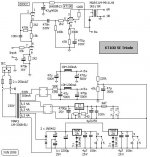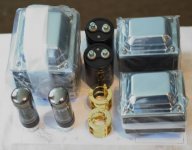Hi guys, i'm planning a KT100 SE in triodemode, what do you think about my schematic so far?
The X-formers comes from www.vt4c.com
The X-formers comes from www.vt4c.com
Attachments
#1)
A Mu-stage for the input is fine, but I have some doubts about using that E83CC. This type has the gain, but not the current sourcing capability. If you need that much gain up front, then I'd change that to a Kimmel with a 6SF5 on the bottom and a 6J5 on top. That way, you get all the gain, and also current sourcing to charge up the Cgk + Cmiller + Cstray of the KT100, and for better clip behaviour during overdrive.
#2)
Since the Mu-stage approximates a CCS load, this bypass is probably superflous. If the Mu-stage is operating correctly, adding that capacitor shouldn't cause the gain to change very much.
#3)
That diode is definitely superflous. It probably won't do any harm, but it doesn't do any good either.
All those DC heater supplies are probably overkill. Unless you're dealing with a very low level signal, AC heating works just as well. You already have the DC bias for elevating the heaters, that should be more than enough.
A Mu-stage for the input is fine, but I have some doubts about using that E83CC. This type has the gain, but not the current sourcing capability. If you need that much gain up front, then I'd change that to a Kimmel with a 6SF5 on the bottom and a 6J5 on top. That way, you get all the gain, and also current sourcing to charge up the Cgk + Cmiller + Cstray of the KT100, and for better clip behaviour during overdrive.
#2)
Since the Mu-stage approximates a CCS load, this bypass is probably superflous. If the Mu-stage is operating correctly, adding that capacitor shouldn't cause the gain to change very much.
#3)
That diode is definitely superflous. It probably won't do any harm, but it doesn't do any good either.
All those DC heater supplies are probably overkill. Unless you're dealing with a very low level signal, AC heating works just as well. You already have the DC bias for elevating the heaters, that should be more than enough.
->kstagger
Yep, EL156 was on my mind for a moment, but the pricetag and the fact that i had a pair of KT100's made me choose this approach.
->Miles Prower
1/2. Do you think i will improve alot if i insert a feedback loop? I'm kind of allergic to feedback so that's why i chose this design, I'd prefer to use a 6N1P instead but i can't make the figures out for that tube :-(
3. the diode will be removed, it has no function at all.
thanks for your replies!
Yep, EL156 was on my mind for a moment, but the pricetag and the fact that i had a pair of KT100's made me choose this approach.
->Miles Prower
1/2. Do you think i will improve alot if i insert a feedback loop? I'm kind of allergic to feedback so that's why i chose this design, I'd prefer to use a 6N1P instead but i can't make the figures out for that tube :-(
3. the diode will be removed, it has no function at all.
thanks for your replies!
Mr. Triatic said:->Miles Prower
1/2. Do you think i will improve alot if i insert a feedback loop? I'm kind of allergic to feedback so that's why i chose this design, I'd prefer to use a 6N1P instead but i can't make the figures out for that tube :-(
I definitely believe in the benefits of gNFB. There are quite a lot of audiophiles out there who think it's the Spawn of Satan. You can always compromise by making the gNFB variable; that way, you can dial in how much you think it needs to improve the sound, or run open loop if that's your preference. Different kinds of music sound better with different levels of gNFB.
Frank's has data on the 6N1P. There is a difference, however. The 6N1P has a u= 33 which is a lot lower than the u= 100 of that E83CC. You'll get less gain margin for gNFB as well as input sensitivity. If you can live with that, then a 6N1P Mu-stage will have much improved drive capability.
Yep, the GU-50 have catched my interest, too bad i dont have any, if i stumble over a pair, i promise they will end up singleended in my livingroom ;-)
What do you guys think about the working point? I got 460Volts at the choke before the OPT.. it's a bit high i think..
Regarding the 6N1P, i will give it a try, a bit lowish on the µ-side but i will change the 180k to 270k at the grid/earth position, that might help up a bit, the downside with the 6N1P is the filaments thirst of current, a whopping 600mA per tube!!
What do you guys think about the working point? I got 460Volts at the choke before the OPT.. it's a bit high i think..
Regarding the 6N1P, i will give it a try, a bit lowish on the µ-side but i will change the 180k to 270k at the grid/earth position, that might help up a bit, the downside with the 6N1P is the filaments thirst of current, a whopping 600mA per tube!!
Mr. Triatic said:Regarding the 6N1P, i will give it a try, a bit lowish on the µ-side but i will change the 180k to 270k at the grid/earth position, that might help up a bit...
Won't make hardly any difference. The Zo of a Mu-stage is a good deal less than 180K
...the downside with the 6N1P is the filaments thirst of current, a whopping 600mA per tube!!
That heater current isn't really out of line. The 6SN7 also pulls 0.6A of heater current. Price you pay for a high g(m) type, with its fatter cathodes.
Different kinds of music sound better with different levels of gNFB.
I have found this to be very true as well.
- Status
- This old topic is closed. If you want to reopen this topic, contact a moderator using the "Report Post" button.
- Home
- Amplifiers
- Tubes / Valves
- What about KT100 in SE ?

